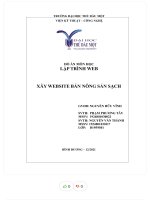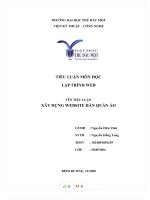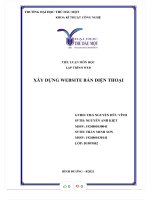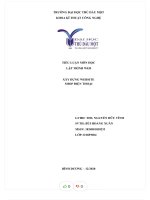SolidCAM2013 HSM HSR machining user guide web v1
Bạn đang xem bản rút gọn của tài liệu. Xem và tải ngay bản đầy đủ của tài liệu tại đây (14.6 MB, 276 trang )
SolidCAM + SolidWorks
The complete integrated Manufacturing Solution
SolidCAM User Guide:
HSR/HSM
iMachining 2D & 3D | 2.5D Milling | HSS | HSM | Indexial Multi-Sided | Simultaneous -5Axis | Turning & Mill-Turn | Solid Probe
www.solidcam.com
SolidCAM 2013
HSR/HSM Module
User Guide
©1995-2013 SolidCAM
All Rights Reserved.
Contents
1. Introduction and Basic Concepts
1.1 Start HSR/HSM Operation............................................................................................... 3
1.2 SolidCAM HSR/HSM Operation overview................................................................... 4
1.3 Parameters and values......................................................................................................... 6
2. Technology
2.1
2.2
2.3
2.4
2.5
2.6
2.7
2.8
2.9
2.10
2.11
2.12
2.13
2.14
2.15
2.16
2.17
2.18
2.19
2.20
2.21
2.22
Contour roughing.............................................................................................................. 12
Hatch roughing.................................................................................................................. 13
Hybrid Rib roughing......................................................................................................... 14
Rest roughing..................................................................................................................... 15
HM roughing..................................................................................................................... 16
Constant Z machining...................................................................................................... 17
Hybrid Constant Z............................................................................................................ 18
Helical machining.............................................................................................................. 19
Horizontal machining ...................................................................................................... 20
Linear machining .............................................................................................................. 21
Radial machining .............................................................................................................. 22
Spiral machining ............................................................................................................... 23
Morphed machining ........................................................................................................ 24
Offset cutting .................................................................................................................... 25
Boundary machining ........................................................................................................ 26
Rest machining ................................................................................................................. 27
3D Constant step over machining ................................................................................. 28
Pencil milling ..................................................................................................................... 29
Parallel pencil milling ....................................................................................................... 30
3D Corner offset .............................................................................................................. 31
Prismatic Part machining ................................................................................................ 32
Combined strategies ........................................................................................................ 33
3. Geometry
3.1 Geometry definition......................................................................................................... 37
3.1.1CoordSys................................................................................................................ 37
3.1.2 Target geometry.................................................................................................... 38
3.1.3 Facet tolerance...................................................................................................... 38
3.1.4 Apply fillets........................................................................................................... 39
3.1.5 Fillet Surfaces dialog box.................................................................................... 40
4. Tool
4.1
4.2
4.3
4.4
Calculate minimum tool length....................................................................................... 45
Tool selection..................................................................................................................... 45
Holder Clearance............................................................................................................... 46
Spin & Feed Rate definition............................................................................................ 47
5. Boundaries
5.1Introduction....................................................................................................................... 50
5.1.1 Drive Boundaries.................................................................................................. 50
5.1.2 Constraint boundaries......................................................................................... 55
5.2 Boundary Definition......................................................................................................... 57
5.2.1 Boundary type....................................................................................................... 57
5.2.2 Boundary name..................................................................................................... 58
5.2.3 Boundary – Tool Relation................................................................................... 59
5.3 Automatically created boundaries................................................................................... 62
5.3.1 Auto-created box of target geometry............................................................... 62
5.3.2 Auto-created box of stock geometry................................................................ 63
5.3.3 Auto-created silhouette....................................................................................... 64
5.3.4 Auto-created outer silhouette............................................................................. 65
5.4 2D manually created boundaries..................................................................................... 66
5.4.1 Boundary Box....................................................................................................... 66
5.4.2 Silhouette Boundary............................................................................................ 67
5.4.3 User-defined boundary........................................................................................ 68
5.4.4 Profile Geometry.................................................................................................. 69
5.4.5 Combined boundary............................................................................................ 70
5.4.6 Select Faces dialog box........................................................................................ 74
5.4.7 Select Chain dialog box....................................................................................... 75
5.5 3D manually created boundaries..................................................................................... 76
5.5.1 Common parameters........................................................................................... 76
5.5.2 Selected faces........................................................................................................ 78
5.5.3 Shallow Areas........................................................................................................ 80
5.5.4 Theoretical Rest Areas......................................................................................... 81
5.5.5 Tool Contact Area................................................................................................ 82
5.5.6 Rest Areas.............................................................................................................. 85
6. Passes
6.1 Passes parameters.............................................................................................................. 89
6.1.1 Wall offset.............................................................................................................. 90
6.1.2 Floor offset............................................................................................................ 92
6.1.3Tolerance............................................................................................................... 93
6.1.4 Step down.............................................................................................................. 93
6.1.5 Step over................................................................................................................ 94
6.1.6 Pass Extension...................................................................................................... 96
6.1.7 Offsets.................................................................................................................. 97
6.1.8 Limits.................................................................................................................... 98
6.1.9 Point reduction...................................................................................................100
6.1.10 Refine corners.....................................................................................................100
6.2 Smoothing parameters....................................................................................................101
6.2.1 Max. radius..........................................................................................................102
6.2.2 Profile Tolerance................................................................................................102
6.2.3 Offset Tolerance.................................................................................................102
6.3 Adaptive step down parameters.................................................................................... 103
6.4 Edit Passes parameters...................................................................................................107
6.5 Axial offset.......................................................................................................................111
6.6 Strategy parameters.........................................................................................................113
6.6.1 Contour roughing...............................................................................................114
6.6.2 Hatch roughing...................................................................................................116
6.6.3 Hybrid Rib roughing..........................................................................................119
6.6.4 Linear machining ...............................................................................................122
6.6.5 Helical machining...............................................................................................126
6.6.6 Horizontal machining .......................................................................................128
6.6.7 Radial machining ...............................................................................................129
6.6.8 Spiral machining ................................................................................................133
6.6.9 Morphed machining .........................................................................................137
6.6.10 Offset cutting .....................................................................................................139
6.6.11 Rest machining parameters .............................................................................. 140
6.6.12 3D Constant step over ..................................................................................... 146
6.6.13 Pencil milling ......................................................................................................150
6.6.14 Parallel pencil milling ........................................................................................152
6.6.15 3D Corner offset ...............................................................................................154
6.6.16 Prismatic Part machining parameters ............................................................. 155
6.6.17 Combined strategy parameters ....................................................................... 157
6.7 Calculation Speed............................................................................................................165
7. Links
7.1 General Parameters.........................................................................................................169
7.1.1 Direction options...............................................................................................170
7.1.2 Order passes........................................................................................................180
7.1.3Retract..................................................................................................................183
7.1.4 Start hint..............................................................................................................184
7.1.5 Minimize reverse linking................................................................................... 185
7.1.6 Minimize full wide cuts..................................................................................... 185
7.1.7 Link by Z-level....................................................................................................186
7.1.8 Link per cluster...................................................................................................187
7.1.9 Min. Profile Diameter........................................................................................188
7.1.10Refurbishment....................................................................................................189
7.1.11Safety....................................................................................................................190
7.2 Ramping Parameters.......................................................................................................191
7.3 Strategy Parameters.........................................................................................................198
7.3.1 Stay on surface within........................................................................................199
7.3.2 Stay down within................................................................................................200
7.3.3 Along surface......................................................................................................201
7.3.4 Linking radius.....................................................................................................204
7.3.5 Link clearance.....................................................................................................205
7.3.6 Horizontal link clearance.................................................................................. 205
7.4 Retracts Parameters.........................................................................................................206
7.4.1Style......................................................................................................................207
7.4.2Clearance.............................................................................................................209
7.4.3Smoothing...........................................................................................................211
7.4.4Curls.....................................................................................................................211
7.5 Leads Parameters.............................................................................................................212
7.5.1Fitting...................................................................................................................213
7.5.2Trimming.............................................................................................................215
7.5.3 Vertical leads.......................................................................................................216
7.5.4 Horizontal leads..................................................................................................217
7.5.5Extensions...........................................................................................................219
7.5.6 Basic approaches................................................................................................220
7.6 Down/Up Mill parameters............................................................................................222
7.7 Refurbishment parameters.............................................................................................226
7.7.1 Min. pass length..................................................................................................226
7.7.2Spikes...................................................................................................................227
8. Motion Control
8.1 Approximation of arcs...................................................................................................231
8.2 Point interpolation..........................................................................................................231
8.3 5th Axis.............................................................................................................................231
9. Miscellaneous Parameters
9.1Message.............................................................................................................................235
9.2 Extra parameters.............................................................................................................235
10. Tool Path Editor
10.1 Opening the Tool Path Editor...................................................................................... 239
10.2 TPE toolbar.....................................................................................................................239
10.3 Editing options................................................................................................................240
11. Examples
Example #1: Rough Machining and Rest Roughing............................................................ 245
Example #2: Hybrid Rib Roughing........................................................................................246
Example #3: Constant Z, Helical and Horizontal machining............................................ 247
Example #4: Linear machining...............................................................................................248
Example #5: Radial and Spiral machining............................................................................. 249
Example #6: Morphed machining and Offset cutting........................................................ 250
Example #7: Boundary machining.........................................................................................251
Example #8: Rest machining...................................................................................................252
Example #9: 3D Constant Step over machining.................................................................. 253
Example #10: Pencil, Parallel Pencil and 3D Corner Offset.............................................. 254
Example #11: Mold Cavity machining................................................................................... 255
Example #12: Aerospace part machining.............................................................................. 257
Example #13: Electronic box machining.............................................................................. 259
Example #14: Mold insert machining.................................................................................... 261
Example #15: Mold cavity machining.................................................................................... 263
Example #16: Mold core machining...................................................................................... 265
Document number: SCHSMUGENG13001
Introduction and Basic
Concepts
1
Welcome to SolidCAM HSR/HSM!
SolidCAM HSR/HSM is a very powerful and market-proven high-speed machining (HSM) and
high-speed roughing (HSR) module for molds, tools and dies and complex 3D parts. It offers
unique machining and linking strategies for generating high-speed tool paths.
SolidCAM HSR/HSM module smooths the paths of both cutting moves and retracts wherever
possible to maintain a continuous machine tool motion–an essential requirement for maintaining
higher feed rates and eliminating dwelling.
With SolidCAM HSR/HSM module, retracts to high Z-levels are kept to a minimum. Angled where
possible, smoothed by arcs, retracts do not go any higher than necessary, thus minimizing air cutting
and reducing machining time.
The result of HSR/HSM is an efficient, smooth, and gouge-free tool path. This translates to
increased surface quality, less wear on your cutters, and a longer life for your machine tools.
With demands for ever-shorter lead and production times, lower costs and improved quality, HSR/
HSM is a must in today’s machine shops.
About this book
This book is intended for experienced SolidCAM users. If you are not familiar with the software,
start with the lessons in the Getting Started Manual and then contact your reseller for information
about SolidCAM training classes.
About the Exercises
The CAM-Parts used for this book are attached in a ZIP archive. Extract the content of the
Examples archive into your hard drive. The SolidWorks files used for the exercise were prepared
with SolidWorks 2013.
The contents of this book and exercises can be downloaded from the SolidCAM website
.
2
1. Introduction
1.1 Start HSR/HSM Operation
To add an HSR/HSM Operation to the CAM-Part, right-click the Operations header in SolidCAM
and choose either HSR or HSM command from the Add Milling Operation submenu.
Manager
The corresponding operation dialog box is displayed.
3
1.2 SolidCAM HSR/HSM Operation overview
Technology
Operation name
Template
Info
Geometry parameters
Tool parameters
Boundary parameters
Passes parameters
Link parameters
Motion control
parameters
Misc. parameters
Parameter illustration
Parameters page
The definition of a SolidCAM HSR/HSM operation consists of the following stages:
Strategy choice
Geometry definition
Tool definition
Boundary definition
Passes definition
Link definition
Motion control definition
Misc. parameters definition
4
1. Introduction
At the first stage you have to choose one of the available machining strategies. The machining
strategy defines the technology that will be used for the machining. For more information on the
machining strategies, refer to chapter 2.
At the Geometry definition stage you have to specify the 3D model geometry that will be machined.
For more information on the geometry definition, refer to chapter 3.
The next stage enables you to choose from the Part Tool Table a cutting tool that will be used for
the operation. For more information on the tool definition, refer to chapter 4.
The Boundaries definition page enables you to limit the operation machining to the specific model
areas. For some machining strategies an additional boundary defines the drive curve of the operation
tool path. For more information on the boundary definition, refer to chapter 5.
In the Passes definition, SolidCAM enables you to specify the technological parameters used for
the tool passes calculation. For more information on the passes definition, refer to chapter 6.
The Link parameters page enables you to define the tool link moves between cutting passes. For
more information on the link definition, refer to chapter 7.
The Motion control parameters page enables you to optimize the calculated tool path according to
the kinematics and special characteristics of your CNC-machine. For more information on these
parameters definition, refer to chapter 8.
The Miscellaneous parameters page enables you to define the non-technological parameters related
to the HSR/HSM operation. For more information on the miscellaneous parameters definition,
refer to chapter 9.
5
1.3 Parameters and values
Most of the parameters used in the SolidCAM HSR/HSM operation receive default values
according to built-in formulas that define dependencies between the parameters. When a number
of basic parameters such a tool diameter, corner radius, offsets, etc., are defined, SolidCAM updates
the values of dependent parameters.
For example, the Step down parameter for Contour roughing is defined with the following formula:
If the tool corner radius is 0 (end mill), the Step down parameter default is set to 1.
If a ball-nosed tool is chosen, the Step down value is equal to the tool corner radius
value divided by 5; for bull-nosed tools the Step down value is equal to the tool corner
radius value divided by 3.
SolidCAM provides you with a right-click edit box menu for each parameter.
6
1. Introduction
View parameter Info
This command displays the Parameter Info dialog box. This dialog box shows the internal parameter
name and the related formula (if exists) or a static value.
The Unfold
The
button displays a brief explanation of the parameter.
button displays the flow chart of the parameter value calculating.
7
Reset
When you manually change a parameter default value, the formula assigned to the parameter is
removed.
The Reset commands enable you to reset parameters to their default formulas and values.
This parameter. This option resets the current parameter.
This page. This option resets all the parameters at the current page.
All. This option resets all the parameters of the current HSR/HSM operation.
8
Technology
2
The Technology section enables you to choose a rough (HSR) or finish (HSM) machining strategy
to be applied. The following strategies are available:
Roughing strategies (HSR):
• Contour roughing
• Hatch roughing
• Hybrid Rib roughing
• Rest roughing
• HM roughing
Finishing strategies (HSM):
• Constant Z machining
• Hybrid Constant Z
• Helical machining
• Horizontal machining
• Linear machining
• Radial machining
• Spiral machining
• Morphed machining
10
2. Technology
• Offset cutting
• Boundary machining
• Rest machining
• 3D Constant step over
• Pencil milling
• Parallel pencil milling
• 3D Corner offset
• Prismatic Part machining
• Combined strategies:
• Constant Z with Horizontal machining
• Constant Z with Linear machining
• Constant Z with 3D Constant step over machining
• Constant Z and 3D Corner offset machining
11
2.1 Contour roughing
With the Contour roughing strategy, SolidCAM generates a pocket-style tool path for a set of
sections generated at the Z-levels defined with the specified Step down (see topic 6.1.4).
12
2. Technology
2.2 Hatch roughing
With the Hatch roughing strategy, SolidCAM generates linear raster passes for a set of sections
generated at the Z-levels defined with the specified Step down (see topic 6.1.4). Hatch roughing
is generally used for older machine tools or softer materials because the tool path predominantly
consists of straight line sections.
13
2.3 Hybrid Rib roughing
The Hybrid Rib roughing is a strategy designed to machine very thin walls. These walls are made of
exotic materials (titanium, graphite) and therefore a traditional approach to their machining can be
difficult and risky. This strategy combines a new roughing and finishing tool path, creating a unique
tool path that should preserve the highest possible rigidity of the part.
14
2. Technology
2.4 Rest roughing
The Rest roughing strategy determines the areas where material remains unmachined after the
previous machining operations (the "rest" of the material) and generates a tool path for the machining
of these areas. The tool path is generated in the Contour roughing (see topic 2.1) manner. Rest
roughing operation uses a tool of smaller diameter than that used in previous roughing operations.
The following image illustrates the hatch roughing tool path performed with an End mill of Ø20.
After the hatch roughing, a Rest roughing operation is performed with an End mill of Ø10. The tool
path is generated in the contour roughing manner.
15
2.5 HM roughing
The HM roughing strategy massively reduces rapid moments by controlling the tool movement
so that it remains on the part, following previous cut paths instead of rapid feeding to the new
position. Additional tool path optimization features include the ability to automatically machine flat
areas only instead of adding extra Z-levels to clean up planar zones. The roughing algorithm also
permits to the use of a large step over (greater than 50%), where an offset algorithm ensures total
coverage of the machining area by adding smooth transition corner pips to clean up any remaining
areas.
The strategy can be easily modified to work in different modes: cavity, core and hybrid spiral passes.
These modes provide different approaches to machine a part.
16
2. Technology
2.6 Constant Z machining
Similar to Contour roughing, the Constant Z tool path is generated for a set of sections created at
different Z-heights determined by the Step down (see topic 6.1.4) parameter. The generated sections
are machined in a profile manner. The Constant Z strategy is generally used for semi-finishing and
finishing of steep model areas with the inclination angle between 30 and 90 degrees. Since the
distance between passes is measured along the Z-axis of the Coordinate System, in shallow areas
(with smaller surface inclination angle) the Constant Z strategy is less effective.
The image above illustrates the Constant Z finishing. Note that the passes are densely spaced in
steep areas. Where the model faces get shallower, the passes become widely spaced, resulting in
ineffective machining. Therefore, the machining should be limited by the surface inclination angle
to avoid the shallow areas machining. These areas can be machined later with a different SolidCAM
HSM strategy, e.g. 3D Constant step over (see topic 2.17).
17









